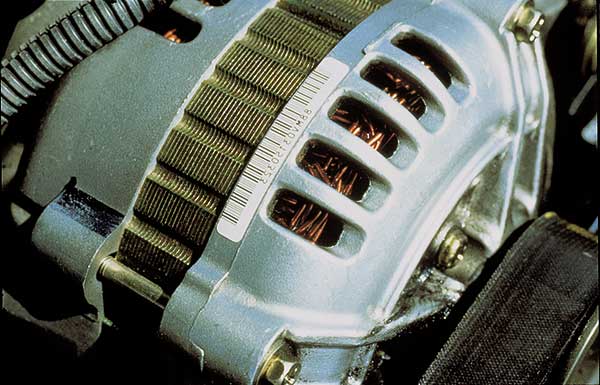Tech Tips
Driven to Succeed: Polymeric Coating Provides Converters with Multiple Opportunities

Today’s marketplace for commercial printers remains challenging. As the economic downturn has led to reductions in print, there are few labeling environments more challenging than those within the automotive industry. Here, labels are subjected to some of the harshest conditions imaginable. Labels must be able to withstand high heat, sub freezing temperatures, and exposure to solvents, chemicals, and UV light. In many cases, they must adhere permanently for the life of the vehicle, which can run into decades.
This labeling can take myriad forms. Some labeling, as in the case of vehicle identification and under-the-hood warning labels, must be permanently adhered for the life of the vehicle. Others, such as tracking and sales labeling, may need to feature an aggressive repositionable adhesive that can be removed cleanly from fabric, glass, painted metal, or plastic.
Fortunately, pressure-sensitive films offer a versatile and enduring solution for automobile labeling needs. These films, which are composed of a substrate, adhesive, liner, and topcoat, can be custom tailored to meet the grueling environment of under-the-hood or under-the-chassis applications. The key to creating a successful label lies in understanding the rigorous demands associated with this field.
Similarly, pressure-sensitive adhesives can perform a variety of functions within the automotive environment. Such adhesives can replace other costly and less effective bonding mechanisms, such as rivets. What’s more, these adhesives can create a water-tight or gas-tight seal, helping to keep the passenger compartment of the vehicle safe. In addition, due to their viscous nature, adhesives can offer vibration and noise damping, enhancing the overall comfort of the vehicle.
Looking at the Pressure-Sensitive Sandwich
To fully understand how label options can be tailored to particular automotive needs, one first needs to understand the components of the pressure-sensitive film sandwich. The sandwich gives design engineers virtually limitless possibilities in meeting the specific requirements of the automobile industry.
The sandwich is comprised of four layers - film, adhesive, topcoat, and liner - of widely varying material components. The success with which product engineers can use pressure-sensitive film to match, say, the gloss level of a dashboard, or the texture of brushed stainless steel, is a function of the film’s face stock – or film layer. There is an almost endless array of colors, gloss intensities and finishes available for the film layer to match or enhance the look of virtually any application. Yet the face stock options go beyond aesthetics. Its material composition, for example, is vital to providing necessary durability characteristics. Film gauges and thicknesses can play an important role as well, and can range anywhere from .5 mil to 10 mil.
The adhesive layer of the pressure-sensitive film is a functional component of the label. A viscous substance when pressure is applied, it enables the label to adhere permanently to the application surface. The product surface, in addition to the environmental conditions the adhesive is likely to encounter, will largely dictate what the adhesive properties should be. These properties are characterized in terms of tack, peel and shear, as well as other attributes such as resistance to chemicals, UV radiation, heat, humidity and other environmental conditions.
The ability of a label to stay adhered to a battery during manufacturing, given that it is in contact with highly concentrated acid, is one example of where this adhesive layer is a key parameter in the automobile industry.
The primary job of the topcoat layer is to ensure proper ink adhesion to the surface of the film. Therefore, depending on the application, topcoats need to be compatible with a range of conventional, UV, and water-based inks, as well as printing methods such as digital, screen-printing, flexographic, letterpress, and offset.
Liners serve a functional process, although they are sometimes viewed as the throw away portion of the sandwich. However, pressure-sensitive film release liners, whether in sheet form or roll form, need to withstand the printing, diecutting, lamination and application steps inherent in the converting process, as well as in the various product testing and manufacturing processes.
Meeting the Needs of a Demanding Environment
The automobile industry requires accountability. Virtually every component of every vehicle needs to be verified, tracked, and accounted for throughout the manufacturing process, often through the use of a bar code label.
In the event of product failure, these labels may provide the only source of information to help OEMs, repair shops, and consumers understand how, when, and why failure occurred.
At the same time, automobile manufacturers must comply with a host of regulatory and safety requirements that involve extensive labeling throughout the vehicle. Everything from battery warning labels to air bag warning labels must function for the life of vehicle to protect both the consumer and OEM.
Labels must endure a wide range of conditions.
Tracking labels may be exposed to gasoline, motor oil, battery acid, or radiator fluid, as well as the cleaning fluids used to wipe away these solvents.
They need to stand up to temperatures that can range from subfreezing to several hundred degrees, and, in the case of an engine block, all within a matter of minutes. Throughout it all, they must remain adhered to their respective surfaces and remain legible.
Fortunately, pressure-sensitive label technology has advanced to meet the needs of this industry. Experienced manufacturers have created labels that have been engineered to offer excellent solvent and chemical resistance. The printed substrate is often protected using a durable overlaminate, helping to seal the information from the harsh conditions. These overlaminates can be custom tailored to meet specific demands. For example, a label for an engine block would likely include an overlaminate that could provide solvent resistance. In contrast, a label that may be adhered to the exterior of the car may feature an overlaminate that would protect it from the effects of UV light and moisture, helping the graphic to remain visible even after long-term weather exposure, including the hottest sunny days and the heaviest downpours.
Labels must also be coated with the right adhesive to help retain its integrity for the life of the product. A weather- and solvent-resistant label is only as good as its adhesive; it does neither the consumer nor the OEM any good if a legible label falls off before it can be read. Similarly, the label cannot interfere with the operations of the vehicle. Take for example the windshield wiper motor label. The part is a critical component when the vehicle is operating during a rain storm on a highway. The label in the sub system must not interfere with the operation of that device. A more drastic example is that of the label in the air bag canister. Here an interfering label could cause an airbag not to functional properly, possibly resulting in injury or death.
Securing Component Integrity
In addition to tracking a part through the manufacturing process, automobile labels can also serve as verification tools, ensuring product authenticity and providing evidence of tampering, a quality of primary importance to retailers and manufacturers. These security labels can be adhered to a variety of at-risk component.
This is particularly critical in the automotive market, where OEM parts are a crucial element of a vehicle’s integrity. OEMs have a legal and financial interest in making sure that only their authorized parts are used in the repair and maintenance of their vehicles. For the consumer, the use of authentic parts can literally be a life or death issue, as in the case of brake pads.
Security, as it pertains to products, generally centers around the protection of company profits and ensuring customer safety. Security requirements can be classified as overt, covert, and forensic (traceability). Product security strategy in the overt sense might take the form of a label that is holographic in nature. For instance, the popular Intel Inside label found on some computers is very visible confirmation of the product’s authenticity, and it is designed so the consumer can clearly see it. The absence of this security label may raise questions.
This same approach can easily be applied to automotive labeling. Today, many OEMs desire that the automotive parts be authentic to survive the operating environment and not cause problems with the integrity of any sub-systems. For example, putting inferior brake fluid in the car’s braking sub-system could damage the master cylinder - or worse.
An example of a covert security strategy is the ability to have a label turn a certain color or otherwise change its appearance when it encounters a set of conditions that would compromise the label or its message. The actual label change is undetectable to the human eye, but with the appropriate detection equipment, it would become clear that the product was a counterfeit or had been damaged. This gives the warranty provider and manufacturer legal grounds to void the warranty and reduce product lifecycle costs.
Authenticity labels may feature encoded messages that allow for authenticators to verify the integrity of the part easily. Holographic films, for example, may incorporate overt (obvious) and covert (hidden) security devices to help both the consumer and parts manufacturer determine the validity of the part’s origin.
The third example of product security is product traceability, which is part of the product manufacturer’s forensic strategy. For example, an authenticated unique label identifying each contract manufacturer can help a forensic analysis team in the event of a compromise in security. This allows the product manager or owner to understand what has happened and then evaluate or otherwise limit liability.
Other labels provide tamper-evident elements so that OEMs can easily determine if someone has tampered with a part, perhaps voiding its warranty. Some films are custom engineered to destruct upon removal, making them impossible to re-adhere. Some films employ a combination of permanent and removable adhesives. These can leave behind a pattern if someone attempts to remove a label, and render the label ruined and, therefore, unsuitable to be re-adhered.
Rely on Experience
OEMs, vehicle designers, and label manufacturers can take advantage of the new and exciting opportunities awaiting them in the adhesive and labeling market for automotive applications by partnering with an experienced polymeric-coating supplier.

